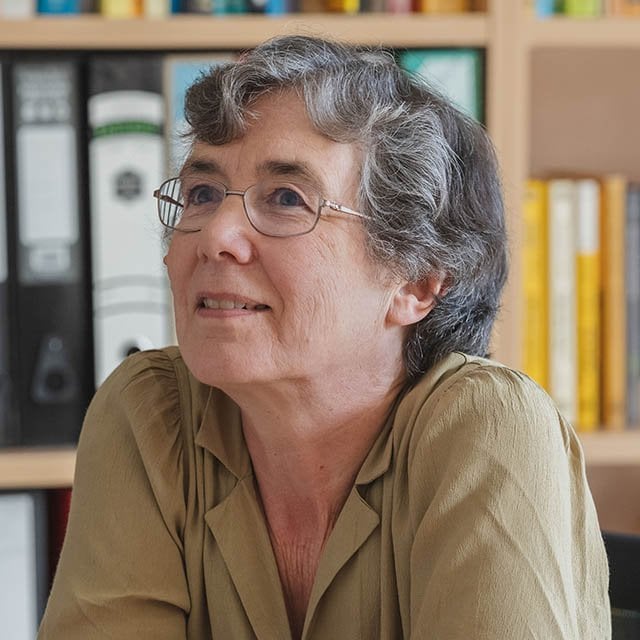Professor Frances Kirwan
Europe – Pure mathematics

Harnessing mathematics to shine a light on complex questions
Professor Frances Kirwan is rewarded for her exceptional work in pure mathematics, with particular reference to her studies of the algebraic and topological properties of geometric objects. She explores classification questions in algebraic geometry, which lead to the study of moduli spaces. What is now called the ‘Kirwan map’ helps to describe the topology (i.e. the shape) of these moduli spaces. Her research has been used by theoretical physicists to understand the structure of possible mathematical models of our universe.
Potential applications of her more recent work could help scientists to illustrate the shape of large, complex data sets (a research area known as topological data analysis or TDA).
“Algebraic geometry has a long and rich history, going back to the ancient Greeks,” she says. “It builds on many other areas of mathematics, with diverse interactions with other sciences. The flow of ideas from algebraic geometry to applications has often been very slow, with the real scientific impact only becoming apparent over time. In recent years, however, the process has been accelerating, with the new research area of applied algebraic geometry developing fast.”
Finding inspiration in mathematics
One of her first mathematical memories is of her father explaining to her a proof that the angles of any triangle add up to 180 degrees. The idea that something like this (or the theorem of Pythagoras) could be proved to be always true was very appealing. In her childhood, the Apollo missions to the moon and later the possibility of mathematical descriptions of the movement of the planets and stars caught her attention. While she was also interested in history and classical languages, at university, Professor Kirwan dedicated her studies to mathematics, keen to deepen her knowledge of this fascinating discipline.
One Eureka moment happened when she was collaborating with the Canadian mathematician Lisa Jeffrey to prove a famous physicist’s formula; while she was bathing her children one evening, a potential mathematical argument occurred to her, and it turned out to complete the proof they were seeking. The collaboration with Professor Jeffrey was critical to building momentum in Professor Kirwan’s career, and many other subsequent local and international collaborations have been equally important.
Diversity and collaboration in science is the way forward
Professor Kirwan has been fortunate to have supportive teachers and colleagues throughout her career. During her time as a graduate student and later a faculty member in Oxford’s Mathematical Institute in the 1980s, there were ten women with permanent faculty positions in the department, enabling her to have both female (and male) mentors and role models. As a senior woman scientist, she is fully supportive of greater gender diversity in science. “It’s very important to have diverse role models, women in particular, but also other sorts of diversity,” she says, noting that this is particularly crucial in areas such as mathematics, theoretical physics and computer science. She believes in the importance of the flow of ideas between different scientific disciplines, which requires the hard work of many individuals working across traditional boundaries to transform mathematical discoveries into game-changing practical applications. When she began her research career, she was excited by the emerging interactions between algebraic geometry and theoretical physics, and more recently, she has observed important connections with biological sciences. Indeed, collaboration with diverse scientists has enabled her to build significant momentum on her own scientific journey.
Beyond this, her dream is that “science in general will provide solutions to the climate crisis that politicians worldwide will be willing to adopt in time to protect the environment for future generations”.
Empowering women to enter science and mathematics
Supporting more women to enter mathematics is a passion for Professor Kirwan, and she has devoted much of her time and resources to encouraging girls and young women into mathematics at a national, European and international level. Through the London Mathematical Society and the United Kingdom Mathematics Trust (whose Councils she chaired at different times), she was involved in the organization of enriching activities for girls at secondary school, such as a mathematics competition called the European Girls’ Mathematical Olympiad. For some time, she was deeply involved with the European Women in Mathematics organization (EWM), through which she helped to coordinate the first international conference of women mathematicians in Hyderabad, India, in 2010, organized in partnership with the International Congress of Mathematicians. She herself is the recipient of multiple accolades, including being the first woman elected to one of the oldest and most prestigious mathematics chairs at Oxford University (Savilian Professor of Geometry), established in 1619.
Professor Kirwan believes that many women mathematicians are willing / engaged to help achieve a societal or environmental benefit through their research. “I would wholeheartedly recommend a career in mathematics. There are so many interesting areas to explore and opportunities to collaborate with scientists from multiple disciplines towards discoveries that could help to transform our world for the better.”